| Article ID | Journal | Published Year | Pages | File Type |
|---|---|---|---|---|
| 1932992 | Biochemical and Biophysical Research Communications | 2010 | 6 Pages |
It has been well established that estrogen is involved in the pathophysiology of breast cancer. Estrogen receptor (ER) α appears to promote the proliferation of cancer tissues, while ERβ can protect against the mitogenic effect of estrogen in breast tissue. The expression status of ERα and ERβ may greatly influence on the development, treatment, and prognosis of breast cancer.Previous studies have indicated that the deleted in breast cancer 1 (DBC1/KIAA1967) gene product has roles in regulating functions of nuclear receptors. The gene encoding DBC1 is a candidate for tumor suppressor identified by genetic search for breast cancer. Caspase-dependent processing of DBC1 promotes apoptosis, and depletion of the endogenous DBC1 negatively regulates p53-dependent apoptosis through its specific inhibition of SIRT1. In addition, DBC1 modulates ERα expression and promotes breast cancer cell survival by binding to ERα.Here we report an ERβ-specific repressive function of DBC1. Immunoprecipitation and immunofluorescence studies show that ERβ and DBC1 interact in a ligand-independent manner similar to ERα. In vitro pull-down assays revealed a direct interaction between DBC1 amino-terminus and activation function-1/2 domain of ERβ. Although DBC1 shows no influence on the ligand-dependent transcriptional activation function of ERα, the expression of DBC1 negatively regulates the ligand-dependent transcriptional activation function of ERβin vivo, and RNA interference-mediated depletion of DBC1 stimulates the transactivation function of ERβ. These results implicate the principal role of DBC1 in regulating ERβ-dependent gene expressions.
